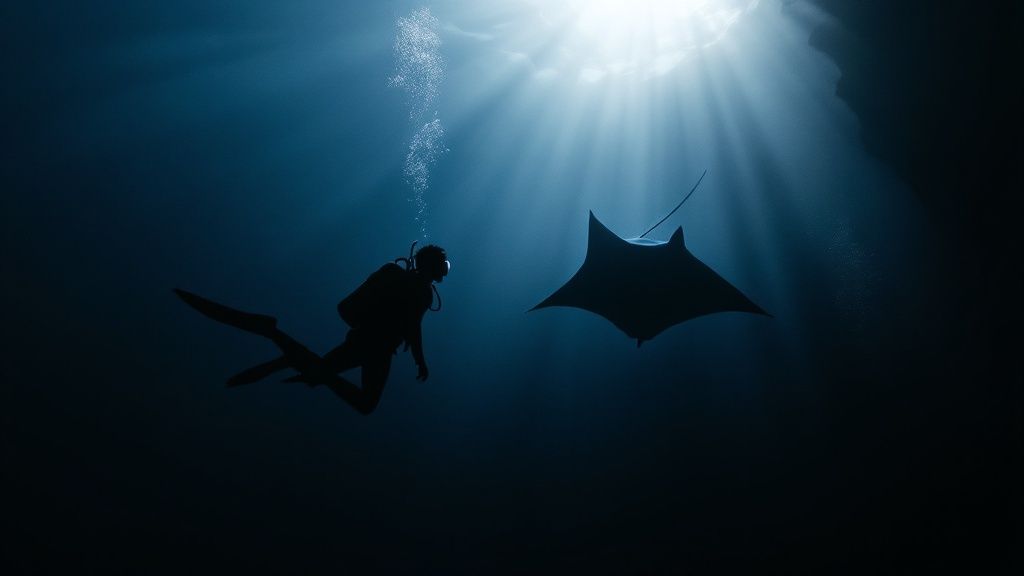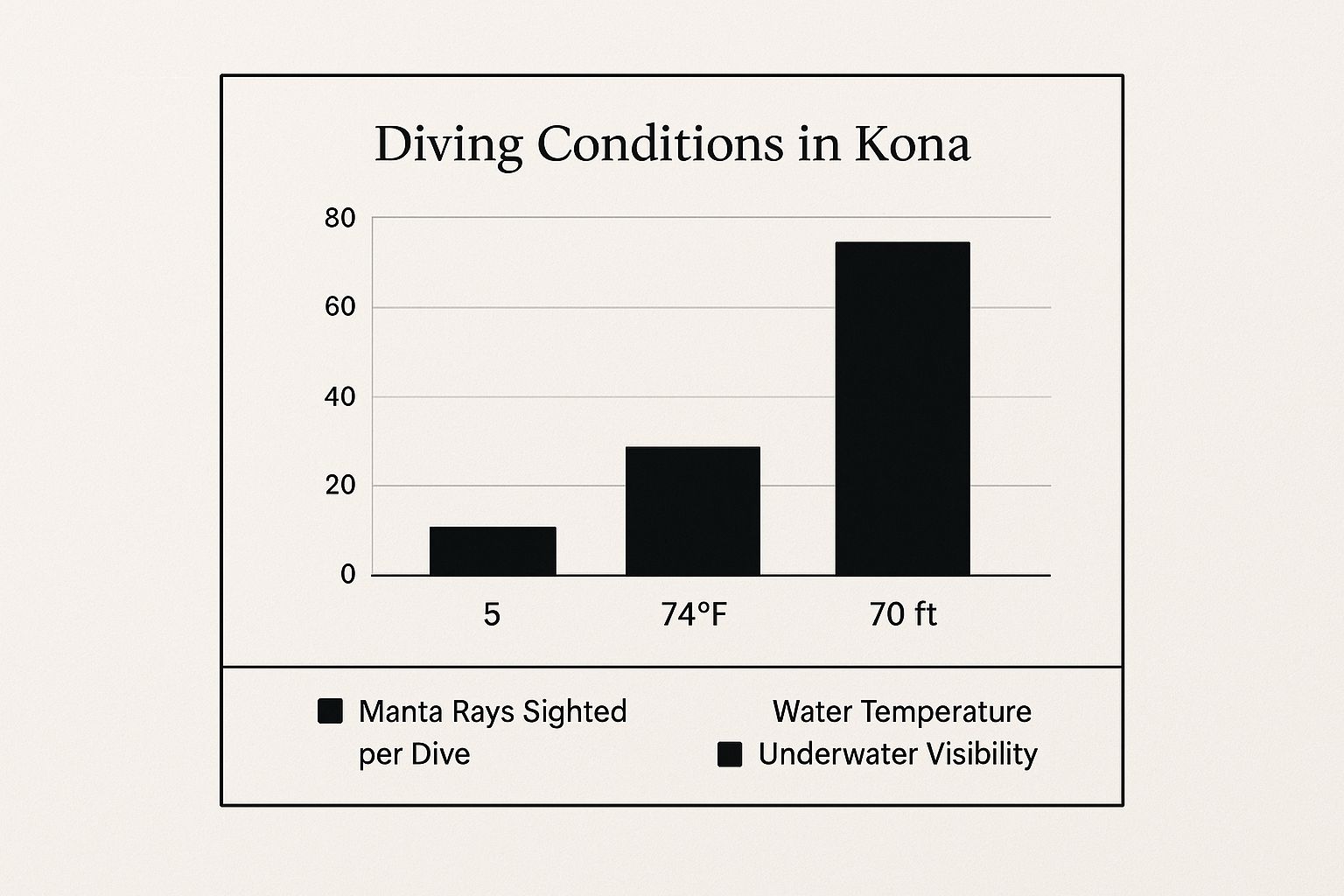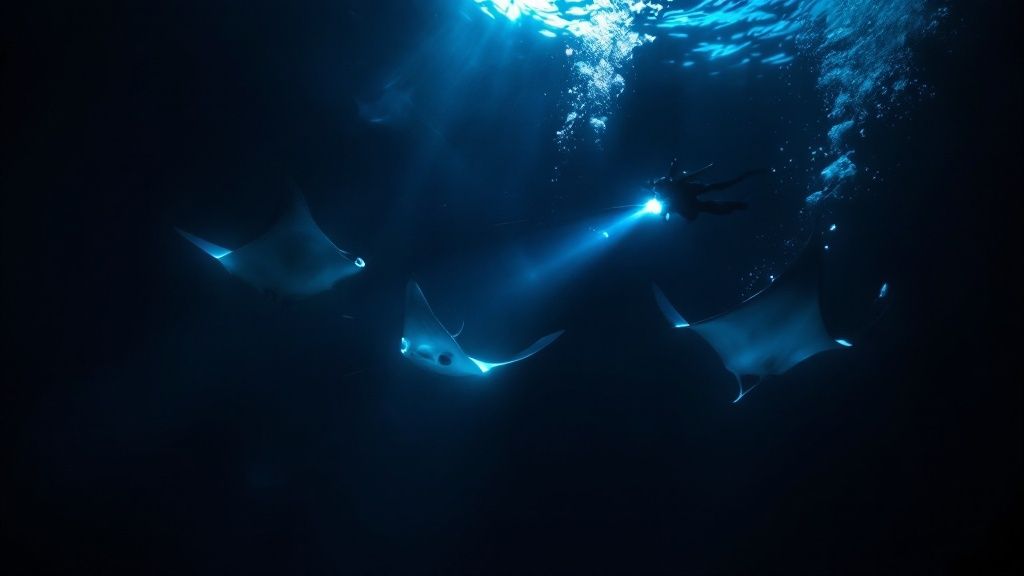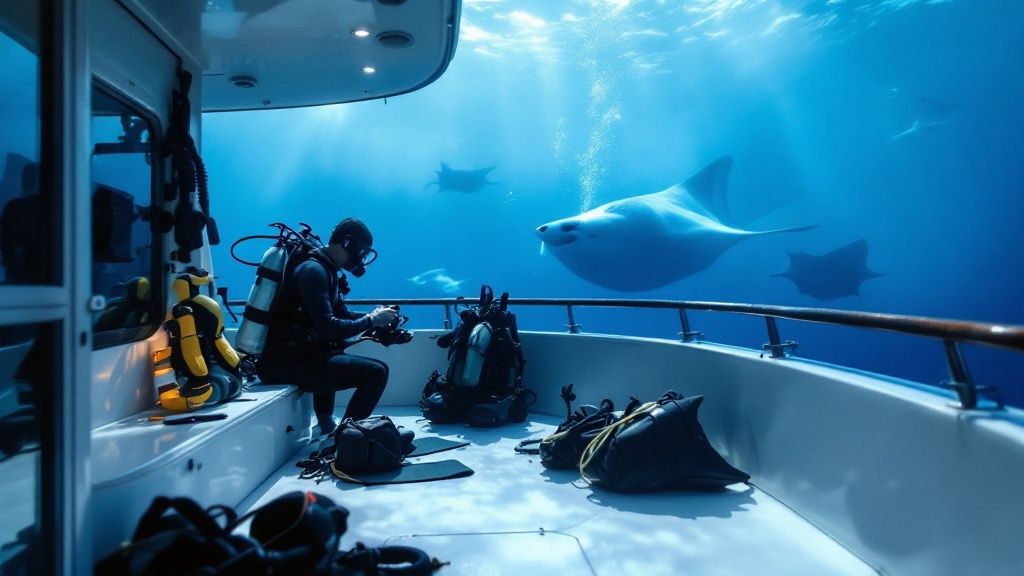Why Kona's Manta Ray Experiences Stand Out Worldwide
Kona, Hawaii, isn't just a beautiful island; it's a global hotspot for manta ray encounters. Several factors converge to make the Kona manta ray dive truly special, setting it apart from other locations worldwide. These include ideal water conditions, unique dive site topography, and a thriving ecosystem supporting a robust manta ray population.
The Perfect Combination of Nature and Infrastructure
One reason for Kona's success in manta ray tourism is its pristine environment. The crystal-clear waters have exceptional visibility, often exceeding 70 feet. This allows divers and snorkelers to fully appreciate the size and graceful movements of these gentle giants. The consistently warm water creates a comfortable environment for both the manta rays and the people who come to see them. This accessibility makes the experience enjoyable for everyone, from experienced divers to first-time snorkelers.
This natural beauty is enhanced by a well-established dive industry catering specifically to manta ray encounters. Kona dive operators have developed specialized infrastructure, such as strategically placed lighting systems. These lights attract plankton, the manta rays' main food source. This creates predictable feeding areas, ensuring a high probability of manta ray sightings for visitors. You can learn more about the best time to visit: When is the best time of year to see manta rays in Kona?
A Thriving Ecosystem and Responsible Tourism Practices
The Kona Coast boasts a rich ecosystem that supports a large manta ray population. Nutrient-rich currents create perfect conditions for plankton blooms, attracting these magnificent creatures. The Kona Coast is a world-renowned destination for manta ray dives and snorkeling, attracting an estimated 80,000 participants annually. This underscores Kona's status as a major ecotourism center, with nightly tours running year-round. These tours boast an impressive 80-90% sighting success rate. More detailed statistics can be found here.

The local dive community in Kona embraces responsible tourism. They work closely with researchers to ensure the long-term health of the manta ray population. This collaboration benefits both the visitor experience and ongoing research and conservation efforts. The careful monitoring of individual manta rays, identified by their unique belly patterns, provides invaluable data for ongoing studies.
An Unforgettable Underwater Adventure
What truly sets the Kona manta ray dive apart is its potential for a profound experience. Witnessing these graceful creatures up close in their natural habitat leaves a lasting impression. The combination of favorable environmental conditions, established infrastructure, and responsible tourism practices creates an exceptional experience. This continues to attract visitors from all over the world. You can learn more about why you should experience this: Why should you go on a manta ray dive in Kona?.
Discovering Kona's Premier Manta Ray Sanctuaries
Kona, Hawaii, offers a truly special experience: diving with manta rays. These incredible creatures gather at specific sites, not just any random location, creating unforgettable encounters for divers. Let's delve into two of Kona's most famous manta ray havens: Manta Village and Manta Heaven. Curious about why Kona is such a hotspot? Find out more: Why should you go on a manta ray dive in Kona?
Manta Village: A Shallow Oasis
Just off the coast of the Kona International Airport, Manta Village welcomes divers with its shallow, calm waters. This makes it perfect for beginners and those new to night diving. The sandy bottom provides an ideal environment for plankton, the manta rays' main food source. The unique lava formations add a dramatic touch to this already spectacular experience. Local divers often recommend Manta Village for reliable close encounters, especially during the summer months when plankton blooms are at their peak.
Manta Heaven: A Deeper Dance
North of Manta Village, Manta Heaven awaits. This deeper site provides a different perspective on manta ray behavior. While the deeper waters and slightly stronger currents can be more challenging, experienced divers are often rewarded with breathtaking displays. Larger groups of manta rays gather here, showcasing dynamic feeding behaviors. The "barrel roll" feeding technique, where mantas gracefully spiral through the water while filtering plankton, is a common sight at Manta Heaven.

Kona boasts impressive conditions for manta ray sightings. With an average of five manta rays per dive, a comfortable water temperature of 74°F, and visibility up to 70 feet, it's a manta ray lover's paradise.
To help you choose the perfect dive site, we've compiled a comparison table highlighting the key features of both Manta Village and Manta Heaven.
Kona Manta Ray Dive Sites Comparison: A comprehensive comparison of the primary manta ray dive sites in Kona, including location-specific information to help divers choose the best site for their experience level and preferences.
| Dive Site | Average Depth | Best For | Success Rate | Typical Group Size | Special Features |
|---|---|---|---|---|---|
| Manta Village | Shallow | Beginners, Night Divers | High | Small – Medium | Calm waters, Lava formations |
| Manta Heaven | Deeper | Experienced Divers | High | Medium – Large | Barrel roll feeding |
This table summarizes the main differences between the two sites, helping divers of all skill levels make an informed decision. Manta Village caters to those seeking a calmer, shallower experience, while Manta Heaven offers a more challenging dive with the potential for observing more complex manta ray behaviors.
Kona offers a truly unique dive experience compared to other Hawaiian locations. Interested in exploring other islands? Check out Honolulu for a different island vibe. Each dive site's distinctive characteristics, combined with Kona's clear waters and responsible dive operators, make for an exceptional experience.
The Remarkable Science Behind Kona's Manta Ray Population
The magic of a manta ray dive in Kona isn't just about the stunning visuals; it's grounded in fascinating scientific research. This research constantly expands our knowledge of these gentle giants and guides crucial conservation efforts. A core aspect of this research involves identifying and tracking individual manta rays.
Unveiling Individual Identities: Nature's Fingerprints
Scientists use the unique ventral patterns on each manta ray—the spots and markings on their undersides—as a natural form of identification. Like human fingerprints, these patterns are distinct, allowing researchers to tell individual mantas apart within the population. This identification is crucial for long-term monitoring.
This allows researchers to follow individual movements, learn migration patterns, and assess overall population health. By understanding these fundamental aspects of manta ray life, researchers can develop targeted conservation strategies.
Decoding Behavior Through Long-Term Monitoring
Meticulous tracking reveals vital information about manta ray behavior. Observing individuals over time allows scientists to uncover their social structures, communication methods, and even their unique personalities. This data reveals how these creatures navigate, interact, and flourish in their environment.
Understanding these behaviors also informs effective conservation strategies, helping to protect the delicate balance of the Kona ecosystem. By gaining insights into the daily lives of manta rays, we can better understand their needs and vulnerabilities.
Advanced Feeding Strategies and Conservation Efforts
Research also explores the feeding strategies of manta rays. Their complex filter-feeding techniques, including the captivating "barrel roll" often witnessed during night dives, are a particular focus. Understanding how they find and consume plankton helps researchers grasp their role in the Kona ecosystem.
This knowledge also reveals how manta rays might be vulnerable to environmental shifts. This focus is essential for creating effective conservation strategies. By protecting the food sources and feeding grounds of manta rays, we can help ensure their survival.
Researchers have identified over 290 unique individuals in Kona since 2009 through this painstaking data collection, creating a comprehensive database for research and conservation. Find more detailed statistics here. This invaluable resource is crucial for understanding population trends and informing conservation efforts.
Collaboration for a Sustainable Future
The partnership between the tourism industry and scientists is a cornerstone of manta ray conservation in Kona. Dive operators contribute to data collection by documenting sightings and sharing their observations. This data gives researchers a broader view of manta ray behavior and population dynamics.
Furthermore, revenue from manta ray dive tourism directly supports vital research initiatives. This sustainable model ensures that the very act of observing these incredible creatures contributes to their protection. This collaboration makes Kona a model for responsible manta ray ecotourism and conservation worldwide.
Preparing For Your Manta Ray Encounter
Preparing for your manta ray dive in Kona, Hawaii, requires more than just packing your swimsuit. A little planning ensures a comfortable and memorable experience. This involves strategic timing, the right gear, and understanding the dive process. Check out our guide on diving with manta rays in Hawaii.
Timing Is Everything: Booking Your Dive
To increase your chances of an unforgettable encounter, consider booking your manta ray dive during the new moon phase. The darker nights amplify the plankton's bioluminescence, drawing more manta rays to the illuminated feeding areas. Booking in advance, especially during peak season, secures your spot and gives you more tour time options.
Gearing Up For An Unforgettable Dive
Having the correct gear enhances comfort and enjoyment. A 3mm wetsuit is recommended, even in Kona's warm waters. After sunset, temperatures can drop, and this thickness provides a good balance of warmth and flexibility. Ensure your mask fits well and use anti-fog solution. Apply it liberally before entering the water, and a pre-dive “spit-shine” adds extra protection against fogging. For added buoyancy and relaxation, a pool noodle or other flotation device is helpful.

To help you pack efficiently, we've created a comprehensive checklist:
Manta Ray Dive Kona: Essential Packing Checklist
This table outlines everything you need for a successful manta ray dive in Kona.
| Item | Essential/Optional | Why It's Important | Rental Available? | Notes |
|---|---|---|---|---|
| 3mm Wetsuit | Essential | Warmth and flexibility in cooler evening waters | Yes | Consider a full-body suit for maximum comfort. |
| Mask | Essential | Clear underwater vision | Yes | Ensure a snug fit to prevent leaking. |
| Anti-fog Solution | Essential | Prevents mask fogging for clear visibility | Sometimes | Apply generously before entering the water. |
| Fins | Essential | Easier movement and maneuvering in the water | Yes | Choose fins that fit comfortably and securely. |
| Towel | Essential | Drying off after the dive | Sometimes | A quick-drying towel is recommended. |
| Reef-Safe Sunscreen | Essential | Protects your skin while minimizing environmental impact | No | Apply liberally before and after the dive. |
| Underwater Camera | Optional | Capture memories of your manta ray encounter | Sometimes | Consider a red filter for low-light conditions. |
| Motion Sickness Medication | Optional | Prevents seasickness for a comfortable experience | No | Take one hour before the dive if needed. |
| Pool Noodle/Flotation Aid | Optional | Added buoyancy and relaxation | Sometimes | Helpful for those less comfortable in the water. |
Remember to pack light and prioritize essential items. Most dive operators offer rentals for many of these items.
From Briefing To Underwater Ballet: The Dive Experience
Before you enter the water, your dive operator will conduct a pre-dive briefing. Pay close attention, as they’ll cover safety procedures, manta ray interaction etiquette, and what to expect during the dive. Once in the water, keep a respectful distance from the manta rays. Avoid touching them, as this disrupts their natural behavior and can harm their delicate skin. Position yourself below the manta rays to enjoy an unobstructed view of their graceful movements.
Enhancing Your Experience: Additional Considerations
If you are prone to seasickness, take motion sickness medication about an hour before the dive. Ginger candies or acupressure wristbands can also provide relief. For photographers, remember that underwater photography in low light requires specific settings. A red filter and adjusting your camera for long exposures can help capture the magic of the manta rays under the dive lights.
Special Accommodations: Ensuring Accessibility For All
Even non-swimmers can experience the wonder of manta rays. Many operators provide platforms or rafts, allowing everyone to witness the magic from the surface. Those with limited mobility can often be accommodated with personalized assistance and adaptive equipment, ensuring everyone can enjoy this amazing experience.
Manta Rays in Hawaiian Culture: Ancient Wisdom Meets Conservation
Manta rays hold a truly unique position in Hawaiian culture, going far beyond simply being a popular attraction for divers in Kona. These magnificent creatures are deeply embedded in traditional Hawaiian stories, art, and spiritual beliefs. Known as hāhālua, meaning "two breaths or mouths," this name reflects their distinctive feeding habits. This inherent cultural reverence has naturally led to a profound respect for these gentle giants, forming the basis for ongoing conservation initiatives. Curious to learn more? Check out this Manta Ray Experience Near Waikoloa Village, HI.
Hāhālua: A Symbol of Reverence and Protection
In ancient Hawaiian moʻolelo (stories), hāhālua often symbolize wisdom, grace, and a deep connection to the spiritual world. This inherent respect is grounded in the traditional practice of mālama ʻāina, which emphasizes caring for the land and sea. This philosophy highlights the interconnectedness of all living things, fostering a sense of responsibility to protect the natural world. These beliefs have significantly shaped contemporary conservation approaches.
From Ancient Wisdom to Modern Conservation
Traditional Hawaiian values have deeply influenced modern conservation strategies. The core principle of mālama ʻāina translates directly into sustainable tourism practices that balance visitor access with the well-being of the manta ray population. Regulations governing manta ray dive tours in Kona, for instance, minimize disruption to the animals' natural behaviors. Furthermore, collaborative partnerships between tour operators, researchers, and the local community actively promote responsible tourism.
Among the globally recognized manta ray species—reef manta ray (Mobula alfredi) and giant manta ray (Mobula birostris)—both can be found off the Kona Coast, making the area a vital center for biodiversity. The largest manta ray ever reliably measured reached an astonishing 22 feet (7 meters) across. However, reef mantas, the species typically encountered in Kona, average 12-14 feet (3-5 meters). These gentle giants are even mentioned in the Kumulipo, the ancient Hawaiian creation chant, as 'hāhālua.' Want to know more fascinating facts? Explore these 10 Things You May Not Know About Manta Rays.
Cultural Celebration and Economic Opportunity
The local community has enthusiastically embraced manta ray tourism as both a celebration of their cultural heritage and a sustainable source of economic opportunity. This has created a truly remarkable model where biological conservation and cultural preservation work hand-in-hand. This symbiotic relationship ensures that the economic benefits derived from manta ray tourism directly support the ongoing protection of these incredible creatures. This transforms the manta ray dive Kona experience from a simple thrill into a meaningful contribution to a sustainable future.
Night vs. Day: Choosing Your Perfect Manta Ray Experience

Planning a manta ray dive in Kona? A crucial part of that planning is deciding between a day and a night dive. Both offer unique benefits, resulting in two very different experiences. Understanding these differences is key to selecting the perfect adventure. Read also: Manta Ray Night Dive in the Big Island.
The Magic of the Manta Ray Night Dive
Night dives have become the preferred way to experience manta rays in Kona. This is largely due to the manta rays' feeding habits. After sunset, plankton rises to the surface, drawn by the lights used by dive operators. This creates a feeding frenzy, attracting manta rays that perform captivating barrel rolls and elegant glides as they eat.
This concentrated feeding activity offers a high probability of up-close encounters. The darkness also amplifies the bioluminescence of the plankton. This creates a dazzling light show as the manta rays move through the water, resulting in a truly unforgettable and almost surreal experience.
Daytime Encounters: A Different Perspective
While night dives are certainly popular, daytime manta ray encounters offer their own unique rewards. Visibility is generally better during the day, providing superb photo opportunities. Daytime dives also allow divers to observe natural manta ray behaviors beyond feeding, such as visits to cleaning stations where smaller fish remove parasites.
Daytime encounters, however, are less predictable than night dives. Manta rays may be dispersed over a larger area. While this can make sightings less consistent, the experience can feel more spontaneous and rewarding. The sunlight also creates brighter, more vibrant colors in photographs, capturing the true beauty of the coral reefs and the manta rays themselves.
Choosing the Right Experience for You
So, when is the best time for your manta ray dive? It really depends on your priorities. If you’re looking for guaranteed sightings and the thrill of close-up feeding displays, a night dive is the ideal choice. Exploring cultural perspectives can enrich our understanding of traditions. You may find it interesting to learn about the Cultural Significance of Anti-Hangover Supplements in South Korea. If you prefer enhanced visibility and the chance to witness natural behaviors, a daytime dive might be a better fit.
Consider your comfort level in the water, especially at night. Think about your photography goals. What kind of manta ray interaction are you hoping for? Veteran guides can help you choose the best experience based on your individual preferences. They can also offer advice on seasonal factors that may influence your decision. Ultimately, both day and night dives provide an incredible opportunity to connect with these magnificent creatures in their natural habitat, creating a truly memorable experience.
Swimming With Giants: Ethical Practices for Lasting Conservation
Manta ray encounters in Kona are truly breathtaking. But ensuring these gentle giants continue to thrive requires a commitment to responsible tourism. This goes beyond basic etiquette; it's about actively contributing to conservation efforts and understanding the complex challenges facing manta ray populations. Ultimately, it means making informed choices that support their long-term survival.
Responsible Underwater Practices: Protecting Mantas and Enhancing Your Experience
While enjoying your manta ray dive Kona adventure, certain practices can minimize your impact on these graceful creatures. Never touch a manta ray. Their skin is covered in a protective mucus layer, easily disrupted by human contact.
Maintain a respectful distance, allowing the mantas to approach you on their own terms. Avoid sudden movements or loud noises, which can easily startle them.
By respecting their space and natural behavior, you contribute to a more positive interaction for both you and the manta ray.
Choosing Responsible Tour Operators: Beyond Greenwashing
Identifying truly responsible tour operators is crucial. Look for operators who actively participate in conservation initiatives, partner with research organizations, and educate their guests about responsible manta ray interactions.
Genuine commitment to conservation extends beyond simply displaying eco-friendly logos. It involves demonstrable actions and a deep understanding of the local ecosystem.
Global Challenges and Local Solutions: Your Impact on Conservation
Manta rays face various threats globally, from fishing pressure to microplastic pollution. Your tourism choices directly impact these conservation outcomes. Supporting responsible operators who prioritize sustainability helps fund critical research initiatives.
These initiatives provide crucial data for understanding manta ray behavior, migration patterns, and the overall health of the population.
Tracking Manta Rays: The Importance of Identification
For example, the identification and tracking of individual manta rays through their unique ventral patterns provides valuable insights into their life cycles and habitat use. This information helps researchers understand population trends and develop targeted conservation strategies.
This long-term monitoring is essential for ensuring the sustainable management of manta ray populations.
Community-Based Conservation: A Model for Sustainable Wildlife Tourism
Kona's community-based conservation efforts have become a model for sustainable wildlife tourism worldwide. Local communities have embraced manta ray tourism as both a cultural celebration and a sustainable economic opportunity.
This approach fosters a sense of shared responsibility for protecting these magnificent creatures. This collaborative spirit ensures that tourism benefits not only the local economy but also directly contributes to the conservation of manta rays and their habitat.
By choosing to dive with responsible operators, you directly support these vital initiatives, furthering our knowledge of these amazing creatures and contributing to their long-term survival. Your choices matter. By supporting sustainable practices, you can actively participate in protecting these gentle giants for generations to come.
Ready to experience the magic of manta rays in Kona while supporting lasting conservation? Book your unforgettable dive with Kona Honu Divers today: Dive with Kona Honu Divers
